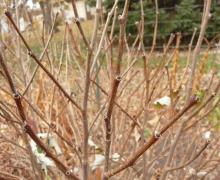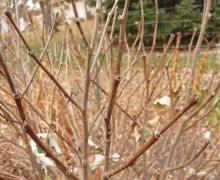Corylopsis pauciflora is always an early bloomer in my garden. This year it is even earlier than usually. Some of the bigger Rhododendrons are flowering too. Here is one truss.
Comments
Re: Early flowering shrubs 2012
Corylopsis is one of the loveliest of early spring shrubs I think - we have yet to get one established well, probably due to our dry summers. Trond do you grow any of the really dwarf rhododendrons? The large ones are no good at all in our garden, but I've always wanted to have a moist shady peat bed for small ericaceous species, which could be looked after and watered through dry spells. They are much less grown in the UK than they used to be, except in the north.
Tim, once I had many lovely dwarf forms but I had planted them among other which grew too big and the small ones slowly succumbed to death. I hadn't realized, coming from Oslo, how huge some of the shrubs of that genus can be! I have many slides of those lost :-\
I have planted some smaller the last years, here's one pictured in 2011 (Rh 'Quail') and another, not of the smallest though, that has survived but grown very leggy: Rh lanatum 'Muncaster Castle'.
Re: Early flowering shrubs 2012
'Muncaster Castle' epitomises how beautiful rhodos are in flower and the leaves have that lovely golden farina to them (I've only really seen that on some of the larger species). There are just too many plants to fall for....!
Re: Early flowering shrubs 2012
Lonicera caerulea has been blooming since mid March. The flowers are not that beautiful, but they bloom even before any pussywillows produce pollen, so they are very welcoming for early foraging bees. This one is one of the early varieties (circa 1996?) called 'Czech no. 17' (Berry Blue™).
Dirca palustris (Atlantic Leatherwood) is supposed to be difficult to transplant, protesting any root disturbance. It certainly did when I received it as a smaller plant that originally came from one of our original Minnesota native plant enthusiasts, May Wright. I transplanted this shrub last spring. Root pruned the previous year, it has done very well, although flowers are noticeably smaller. This one has been bloom for 2 weeks so far, and is on it's way out.
I receive some Corylopsis spicata plants in a trade this spring. The species should be the second hardiest in the genus. It's a long shot for me here in Minnesota, but you never know....
Re: Early flowering shrubs 2012
Rick, Lonicera caerulea is nice. I've read about it - it is the one with rather big edible berries? How do they taste?
I've seen pictures of Dirca and it seems to be one of those plants preferring cold winters and warm summers! Would evidently do better in Eastern Norway than at my place.
Re: Early flowering shrubs 2012
Rick, Lonicera caerulea is nice. I've read about it - it is the one with rather big edible berries? How do they taste?
Selection cultivation is very recent, although native cultures have long gathered Honeyberries (or Haskap) in the wild. It is reportedly very variable, as it has a huge distribution range. People say the taste is difficult to describe, I think because most people aren't very versed in the acid tastes. Mostly you will find it described as blueberry and lemon. I grow five different cultivars, all derived from Russian provenance. There is no hint of lemon. The acid tasted is definitely what is found in grapefruit(a citrus). Secondary is the background blueberry taste. The berries themselves are rather ugly - an unevenly oval shape that can vary, even on the same shrub. On my shrubs, sweetness can vary from year to year, too. Wikipedia has a good pic of the varied shapes:
http://en.wikipedia.org/wiki/Lonicera_caerulea
They are fast growers, so hybridization and selection progresses quickly. They say that the Japanese and Korean provenances are better all around (and especially for taste), and Canada seems to be in the forefront of Haskap development.
I keep my shrubs netted at fruiting time, or birds will snatch everyone. Ripening is extremely early, even here in zone 4 it is late May or Early June. Where I am, I believe it could become invasive with seeds spread by birds. I have sounded the alarm for almost 10 years, but the species is now sold in catalogs all over in America. Apparently, in the southern U.S. it is not vigorous.
They have a peculiar woody stipule like appendage, similar to some Berberis spp., seen here and in the previous pic.
I've seen pictures of Dirca and it seems to be one of those plants preferring cold winters and warm summers! Would evidently do better in Eastern Norway than at my place.
I have never seen the species wild in northern Minnesota or Wisconsin, although it is native in those parts. In southern Minnesota it is restricted to north facing ravine sides, where it is cooler. It does not naturally grow on south facing inclines, even when the shrubs are abundant on the north facing incline of the same ravine. Our summers here, though, are a lot warmer than yours, Trond.
Some more pics from previous years. When flowers first emerge, they are the only growth from the winter buds, and the leaves come a bit later. Bud scales are almost black at that time, and there is a short window when the plant has the brown twigs, black buds scales, bright green little leaves and soft yellow flowers. Each color is very distinct, as if painted, and in my view, quite spectacular. I've never been able to capture it with a film camera, and for the couple years I owned a digital camera, the weather hasn't cooperated. :(
The twigs are very pliable, hence the name "Leatherwood".
Re: Early flowering shrubs 2012
Thanks, Rick. Think I have to try both when I get a chance!



Corylopsis is one of the loveliest of early spring shrubs I think - we have yet to get one established well, probably due to our dry summers. Trond do you grow any of the really dwarf rhododendrons? The large ones are no good at all in our garden, but I've always wanted to have a moist shady peat bed for small ericaceous species, which could be looked after and watered through dry spells. They are much less grown in the UK than they used to be, except in the north.